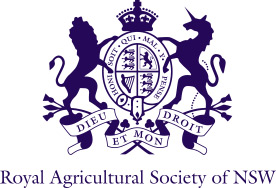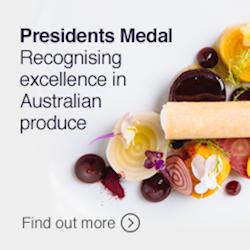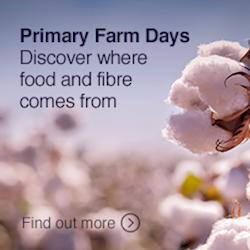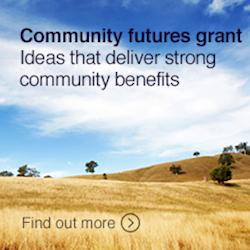The family way
Posted on : 25 August 2016
Five generations of the Downes and Badgery families have served on the Royal Agricultural Society of NSW (RAS) Council. Now, with the election of James Angus, the Angus family share that distinction.
‘I was born on cattle judging day in 1955. Dad was Ayrshires judging while mum was stuck in hospital having me. And I’ve been to every Show since.’ At the cattle lawns at this year’s Show, Councillor Edgar Downes is watching the Charolais go around. As a youth he exhibited cattle, then one day when he was eighteen or twenty years of age his father hauled him in to help steward. He remembers hopping to, quickly tidying himself up for the ring.
It’s a familiar story: growing up with the Show and RAS business entwined in family affairs, then half a lifetime of stewarding culminating in a nomination to Council – all for the privilege of giving more time and effort to the cause. But Edgar Downes, like Brian Badgery and Lorance and James Angus from the other five generation clans, wouldn’t have it any other way.
The Downes family
The Downes family’s contribution began with Jeremiah Downes who arrived in New South Wales in 1842 with Benjamin Boyd on the Wanderer. After gaining colonial experience at Twofold Bay and turning squatter, Jeremiah brought his family to Brownlow Hill near Camden, leasing the property from George Macleay in 1858, and later purchasing it. The Downes family have lived there ever since.
Jeremiah, an expert judge of horses, became a vice president of the Agricultural Society when it re-formed in 1857. It was his son, Frederick, who built up the family’s dairy interests, establishing a Friesian stud and taking a leading role in dairying organisations and agricultural activities centred at Camden. His descendants carried on with all these concerns and today Edgar Downes serves on the RAS Cattle Committee.
The Badgery family
When Brian Badgery, the current Badgery on Council, thinks of his long family history and the RAS, he thinks first of his father, and remembers the effort he made to attend Council meetings. ‘Living near Grafton, more than 600 kms from Sydney, with no airport, and roads not being what they are today, he would travel by overnight train, arriving for Monday morning meetings, and returning overnight Tuesday night. We were dairying at the time, so I was never in doubt about the commitment it took to serve the RAS.’
The Badgerys’ links to agriculture go way back to 1799 when James Badgery settled in New South Wales at the urging of Sir Joseph Banks. The colony was desperate for competent farmers. James proved his skill, taking up land at what is now Sutton Forrest to successfully breed dairy cattle, Merino sheep and thoroughbred horses. In 1868, James’ son Henry was elected to Council. This was a crucial time for the Society, and the decision was made to move the annual Show from Parramatta to Sydney in the hope it would flourish. Both of Henry’s sons became Councillors, but it was one, Henry Septimus Badgery, who made the family name prominent. Taking out an auctioneer’s license as a young man, he set up as a stock and station agent, founding Pitt, Son and Badgery. He famously conducted the first cattle sale at the Homebush saleyards and thanks to his exuberant style was dubbed the ‘King of Homebush’. Three of the ‘King’s’ sons eventually served on Council, leading to an almost continuous record of family service throughout the twentieth century and beyond.
Today, Brian Badgery is hopeful one of his daughters will soon begin stewarding and make her own mark, but there’s no dynastic right that will see her automatically elevated to Council. As Brian says, ‘It’s not all about history. It’s about commitment and dedication to the Show movement.’
The Angus family
As Australia edged towards the twentieth century and modernisation, agriculture and industry became developmentally reliant on each other. The Angus family story has its origin in these years with the arrival of James Angus to Australia in 1879. Coming from Scotland via New Zealand after the railway boom there ended, he took up a contract laying steam tram lines and went on to build railway infrastructure in New South Wales and Victoria. Improved rail links had a major effect, not only on the efficient working of cities, but in helping connect country towns and rural producers with city markets.
James Angus’ engineering work diversified, but he was also keenly interested in agriculture. In 1890 he purchased Minchinbury estate, installing Leo Buring to make sparkling wines. Buring made the first champagne in Australia and his expertise was to have a profound influence on the fledgling Australian wine industry. James Angus was elected to Council in 1899 and his son joined him in 1903. Minchinbury was sold to Penfold and Company, leaving the family to concentrate on grazing and stock breeding while continuing with engineering businesses.
Current Councillor Lorance Angus is the fourth generation and his recently elected son, James, makes the fifth. Lorance was ringmaster for seventeen years, but had the perfect role model in his father, Jim, who was assistant ringmaster from 1954-1984. It means a lot to Lorance to have James following on. ‘I think James really fits the bill. I know exactly what sort of person he’s like... He’s very driven. And he’s used to dealing in big things.’
James was seconded to the Horse Committee and plans to carry on his father’s tradition of inviting the horse stewards to lunch in the Council Stand each year as a thank you for their efforts. He believes strongly in the RAS’ not-for-profit agenda and wants to make a difference when it comes to driving RAS involvement in rural communities. While family ties are important, he also thinks the RAS needs to gather the views and perspectives of people with different backgrounds and beliefs. ‘How can we truly support our rural communities if we don’t have diversified and supportive social connections in those communities? I think that's a big challenge for all of us and it’s certainly a big challenge for me personally.’
Fitting the bill
When family memories double as institutional memories, important knowledge is carried forward. But when it comes to enlisting new Councillors, that kind of generational learning is only a bonus. Willingness and talent are what matters most. Strengths vary: some Councillors are sought out for their industry knowledge, or their business skills and contacts, others for their practical experience and dedication over years. Many are able across a several fields. All have a track record as doers. This was just as true in the past, even if social connections sometimes played a part. Looking back at the individuals who make up the generations of Badgerys, Anguses and Downses, so many founded or belonged to industry bodies, so many toiled for decades on local show society committees, so many served the public good more widely. Of the fifteen individuals making up our five generation families, ten became vice presidents of the Society and many chaired RAS committees: they were not afraid to lead.
In it together
As Brian Badgery, Lorance Angus and Edgar Downes are all quick to point out, Council members aren’t the only folks giving their labour and loyalty unstintingly. ‘So many people involved in the Show are passionate about what they do,’ says Edgar Downes. ‘There are passionate exhibitors and judges, and I love being among them.’ He’s pleased the RAS now recognises the long term effort of many different contributors with the Show Legend awards.
Perhaps Brian Badgery puts it best: ‘Family history is important to exhibitors just as much as Councillors. It has been a whole way of life for many families, and the Show movement is made up of families in many ways. If we lose that sense of belonging, we lose our purpose of being. There are also many families in our community who just like to go to the Show every year. We must not forget them as an important part of our total structure. They’re all part of our Show family.’
WORDS: Vicki Hastrich
Article first appeared in RAS Times July 2016





